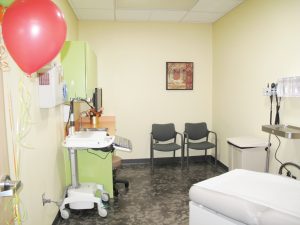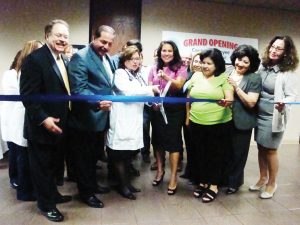The success of the El Paso County Employee Wellness Clinic can be undoubtedly measured in facts and stats, but the recent grand opening of a satellite location speaks volumes.
“The first clinic was so successful that we saw the wisdom in investing in a second one,” remarked El Paso County Judge Veronica Escobar.
The inaugural county clinic located on the first floor of the El Paso County Courthouse opened its doors in June 2011. The satellite clinic housed adjacent to the juvenile probation department in the county’s Family Youth Services Center went operational Jan. 31, 2013. The second site offers extended hours two nights a week, with the hopes of expansion to include additional weeknights and Saturday hours.
Since the opening of the first clinic, El Paso County has logged a pronounced decline in sick leave and related time off.
“Our employees no longer have to take an entire day off work to drive to the doctor’s office, sit in a waiting room, drive to the drug store, and then drive back to work,” Escobar explained. “Rather, they just schedule a visit downstairs and then have their prescriptions delivered to them here at work.”
The county is self-insured, the judge noted, and the investments into these clinics ensures that “our employees are getting preventative health care and catching health issues as soon as possible,” meaning a positive impact on the county’s risk-pool fund.
“We want to try and mitigate the impact of costly visits to our fund,” she emphasized.
Betsy C. Keller, El Paso County’s director of human resources, was in on the planning from day one and has carefully tracked clinic operations and results.
“Most importantly, our employees have access to quality health care services for themselves and their dependents so they can return their focus to work quickly and provide services to our citizens,” Keller maintained.
County Progress asked Keller to explain the “why’s and “wherefores” of a county employee health clinic.
CP: Where did the idea originate?
BK: When I was hired by the county in 2008 as the human resources director, both the commissioners court and the county risk pool board informed me they had wanted an employee health clinic for some time. Many concepts drove the county to be interested in a clinic for its employees.
The El Paso County Commissioners Court has established a culture of responsibly providing benefits for its dedicated public servants, and identified that providing an onsite clinic was a way to give an added benefit to these employees. The commissioners court also realized that access to care is a driver in health care costs.
The county is self-insured, and both the commissioners court and risk pool board are always looking for ways to help control costs. Taxpayers benefit by less funding being required to maintain the county’s benefit costs, and employees benefit by premium costs for insurance requiring fewer increases. Additionally, the county was looking for ways to make our employees aware of the quality of care that was available through the county hospital. The human resources team had identified a county clinic staffed by providers from the county hospital as part of its action plan to raise awareness of the level of service the county hospital provides at a cost savings to the county’s self-insured fund.
CP: When did you start the process?
BK: The county had attempted a clinic originally in 2009. We made some decisions that did not prove to be effective, such as location, interior design (it felt institutional), and structure of service provider. It was in 2010 that we began looking at what we could do differently to create a more successful clinic for our employees and to help manage our costs. We opened the clinic we have now, which has been successful beyond expectations, in June 2011.
CP: What was the cost to El Paso County?
BK: The county spent $17,731 for materials plus internal labor costs for our new and improved clinic. Our internal facilities management team handled the construction and modifications to existing space and was able to turn the project around in approximately three months – and the outcome was better than we had dreamed! It is a beautiful space!
CP: How did the county fund the cost?
BK: El Paso County had funds from bond proceeds that had been designated for courthouse improvements from 2001.
 CP: Please explain how the clinic works – services, staff, times, and cost to employees.
CP: Please explain how the clinic works – services, staff, times, and cost to employees.
BK: The typical services are primary care including but not limited to physical exams, disease management, colds, sore throats, migraines, flu, urinary tract infections, bladder infections, skin irritations, common laboratory tests and EKGs. Women’s health services, in addition to primary care, include annual exams, prenatal care, family planning, and referrals for cancer screenings. Student sports physicals and vaccinations are also available. Clinic services also include urgent care/walk-in type services.
The clinic is staffed by a physician or supervised nurse practitioner; on some days both are available, or we have multiple nurse practioners in the office. An office assistant and two nursing technicians are also onsite.
The clinic in the courthouse is currently open Monday through Friday 7:30 a.m. to 11 a.m., and 11:30 a.m. to 4:00 p.m. The hours at the satellite location, the Employee Wellness Clinic located at the Family Youth Services Center, are Monday through Friday 7:30 a.m. to 4:00 p.m. On Tuesdays and Thursdays, the satellite clinic is open until 8:00 p.m.
There is no copay for county employees and their dependents enrolled under the county’s buy-up or core health benefit plans. The cost for those employees enrolled under the Consumer Driven Health Plan (CDHP) and those who are uninsured is $55 per visit.
Another added benefit is the prescription delivery service the clinic provides. If you need a prescription, the pharmacy will have it brought to the courthouse clinic the same afternoon by 3 p.m.
CP: What is the overall benefit of a county health clinic?
BK: Most importantly, our employees have access to quality health care services for themselves and their dependents so they can return their focus to work quickly and provide services to our citizens.
The financial benefits are significant! At a minimum the county saves $20 per clinic visit versus the lowest charge our risk pool fund receives from a doctor’s office visit. The clinic is averaging more than 350 visits per month. There is no copay for employees compared to our plan, with the lowest copays of $30 per visit. In one year there has been an estimated savings of more than $129,000 for employees and the county combined. When it comes to positive feedback from employees, no copay is clearly a favorite benefit.
Convenience is a benefit employees have shared with me. Productivity is another huge benefit – if you have an appointment and they are running behind, you can go back to your office, and they will call you when they are ready. The ability to be seen on short notice is another benefit the employees have experienced. This in turn helps reduce costs of care due to the illness or injury going untreated and escalating to a higher level of care.
Additionally, the amount of utilization at the county hospital by plan participants for hospital services has also increased.
CP: Lessons learned?
BK: Don’t give up if at first you do not succeed! Always monitor and re-evaluate so you can address any needed changes. However, once it takes off, be prepared to address the concerns of the clinic becoming backlogged. With our initial clinic we would have less than 100 visits per month on average, and now we have some months with 400-plus visits! With this growing demand we evaluated what areas of the county the individuals accessing the clinic were coming from and used it to support and implement opening a second location which just launched on Jan. 31. This satellite location will offer extended hours two nights a week to start, and we hope to expand this to include more weeknights and Saturday hours in the future.
Also, make sure department heads know the value of the clinic. At first they may experience more employees “going to the clinic” and need to be well informed on how to manage the process. For example, we made it clear that employees must use sick leave for the time spent at the clinic.
Use all of your resources to get it done! It took everyone – commissioners court; risk pool board; other elected officials and department heads; the human resources team; our third party administrator, Healthscope Benefits; our health plan consultant, Randy McGraw of JDW Consulting; University Medical Center; and county employees – to get this done and make it successful!
CP: Do you have any advice to other counties interested in establishing a clinic?
BK: Conduct a cost analysis comparing clinic operation costs versus regular physician visits. Plus, look for areas where you can make other financial gains when you negotiate a contract with your service provider. For example, we evaluated the average cost of the 40 most popular lab tests our health plan participants had done and found the average cost was $29. In our contract with the county hospital, we negotiated to pay $20 total for each set of up to three tests a patient receives. So, even if the employee only receives one test, on average we are saving $9. If they receive all three tests, we are saving $67 on average.

















